Category — Cleveland, Full
THE FUNNIEST RABBI
IN CLEVELAND
I ran into a funny rabbi the other night. Happens. Some rabbis are funny. Rabbi Matt Eisenberg told me he is the “second funniest rabbi in Cleveland.” Why number-two? He explained he came in second in Cleveland’s Funniest Rabbi Contest in 2011. Fourteen years later, he’s still funny. He did a clever Purim shpiel based on Fiddler on the Roof.
I was a judge at the funniest rabbi contest once, but not the year Rabbi Eisenberg participated. I was a judge a couple years later. The winner that year wasn’t even a rabbi. The funniest rabbi in Cleveland in 2013 was a doctor/mohel — Kiva Shtull.
The judges made comments after each rabbis did their shtick. We rated the ravs. Afterward, an audience member said to me, “You were very nice in your comments.”
Why not? Author Theodore Dalrymple wrote (about “comedian” Boris Johnson of England), “Telling a joke that falls flat is an excruciating social experiment.” Telling original jokes, non-stop, in front of 200 people at the Schmaltz Museum of Jewish Heritage — that’s not for the faint of heart or your typical pulpit rabbi. I had stocked-piled complimentary adjectives in advance. My arsenal was droll, gut-busting (didn’t use that one), cheery, sharp, zany, wacky, witty and perturbing.
Nobody was perturbing, unfortunately.
I gave the highest rating to the mohel, who moonlighted as the spiritual leader of Congregation Shir Shalom in Bainbridge Township, Ohio. He got wry, droll and zany. (The shul went under about a year later. I don’t know why.)
I just rediscovered a video of Dr. Shtull’s comedy routine. It holds up, at least for the first couple minutes. I’m not sure if Rabbi Eisenberg — the second funniest rabbi of 2011 — has a video. Probably. But check out Shtull’s shtick. Listen at least till you hear the word Chabad — around the two-minute mark.
March 19, 2025 2 Comments
TWO OLD COPS
AND ONE YOUNG MAN
The cops had 66% retirement pensions and hung around McDonald’s on Lake Shore Boulevard in North Collinwood. Mostly Slovenians. They were hard-pressed to find a Jew — besides me — to share stories with. These cops had worked with Jews back when Jews lived in the city.
Bill Tofant, a retired cop, said he had worked out every day at the “Yiddishe Meat Cutters Union,” a k a the YMCA. He said, “I can still run a mile at age 73 and can hold my own in fisticuffs, and I can turn my head to see if traffic is coming.”
Tofant said my Great Uncle Itchy Seiger would throw his arms around Bill every time he came into Seiger’s deli on East 118th Street and Kinsman Road. “I couldn’t even spend a nickel in Seiger’s. I had corned beef, turkey, you name it.”
 Tofant and fellow retried policeman Ray Lonchar ignored the sign in McDonald’s dining area: 30 Minute Time Limit While Consuming Food. The manager must enforce these rules. Your cooperation is appreciated. Tofant and Lonchar had known Botnick the pawnbroker — “a good sharp yidl.” Botnick got shot and killed in 1981 at his pawnshop at East 59th Street and Euclid Avenue. I knew Botnick. My dad used to play tennis with Botnick. Lonchar said, “That was done by a jig. Three colored guys went in back and they stuck the place up, and the cameras were just installed. One guy had a horse pistol, yea-long, it stuck out like a sore thumb. It was a military weapon. They picked him up in Rolla, Missouri.”
Tofant and fellow retried policeman Ray Lonchar ignored the sign in McDonald’s dining area: 30 Minute Time Limit While Consuming Food. The manager must enforce these rules. Your cooperation is appreciated. Tofant and Lonchar had known Botnick the pawnbroker — “a good sharp yidl.” Botnick got shot and killed in 1981 at his pawnshop at East 59th Street and Euclid Avenue. I knew Botnick. My dad used to play tennis with Botnick. Lonchar said, “That was done by a jig. Three colored guys went in back and they stuck the place up, and the cameras were just installed. One guy had a horse pistol, yea-long, it stuck out like a sore thumb. It was a military weapon. They picked him up in Rolla, Missouri.”
There had been another Jewish pawnbroker, at East 79th Street and Hough Avenue. “He would buy a stove [gun] that was red hot and smile,” Lonchar said.
There was Uncle Ben, too, at Woodland Avenue and East 55th Street. “He was kind of lax with his records, but he was good to our pawn unit,” Lonchar said.
When the cops ran out of Jew-lore, they segued to Italians, or even Lithuanians. Blacks — nope. “Shondor Birns [a Jewish gangster] — he had the colored in line,” Lonchar said. Birns had controlled the city’s numbers racket.
I patronized the Lake Shore Boulevard McD’s in the mid-1980s, during the dying days of white ethnicity. Back when cars had bumper stickers like “Thank God I’m Slovenian,” “Thank God I’m Irish” and “Thank God I’m Polish.” Funny, I never saw a “Thank God I’m Jewish.”
The Lits (The Lithuanians) . . . They lived near Our Lady of Perpetual Help Church — very close to McDonald’s. Lonchar said, “DPs — I don’t care what nationally they are — they’ll eat nothing but soup for 20 years, three times a day, and save their money, and all of a sudden they buy apartment buildings, invest, and they start rolling. They found out that the streets of America didn’t have gold in them. They had to work for it.”
The Italians . . . with all their “goddamn Italian bullshit.” The Italians lived near Holy Redeemer Church, approximately two miles from McDonald’s. Tofant said, “One thing about Italians, they stick together. If you’re Italian, you’re better than me. You might be the dumbest SOB on two feet, a goddamn dunderhead, but just because you’re Italian, you’re it. The Irish get the way, too, around St. Patrick’s Day.”
The Poles . . . Tofant said, “There was one Polack, Frankie Schant, a safecracker. He bit the cheese and left an imprint. He bit the cheese at the grocery store and they matched his teeth marks. At Pick-N-Pay. And there was this South Side Polack who cut a wire, it was live, and he died.”
Slovenians . . . the best for last, here. Take Charlie Broeckel. (He might not have been Slovenian but the Slovenians claimed him.) Tofant said, “He had class. He went out to Laguna Beach, California, and did a bank heist there. Burned through seven mill worth of shit and negotiable papers. I knew him when he was 10 years old. He was a runner. He always found his way out. And you know what, his mother held a very respectable job. She was beyond reproach, nothing like a stumblebum or anything like that. They lived at 8815 St. Clair.”
Nail a historical plaque to that door!
—
I was doing research — and legwork — for a cop novel back then. (Unpublished novel.) I’ll briefly quote the manuscript, if I can find it. Found . . .
“Stan Zupancic had a glazed turquoise ashtray contoured in the shape of a .44 magnum. His pencil holder was made from World War II antitank shells, and he used a bowie knife to open his mail. A young man, with a growth of brown curly hair that looked like a dead shrub, sat on the other side of the desk.”
December 11, 2024 3 Comments
TICKTIN: THE LAST OF
THE KINSMAN COWBOYS
Harold Ticktin died on November 12 at 97. He was the last of the Kinsman Cowboys — guys who hung out on Kinsman Road and BS’d (pre-internet and TV). This blog post is a thoroughly “reported” piece on the only-and-only Ticktin. It helps that I wrote it 12 years ago, while Harold was still alive. I was in steady contact with Harold throughout the years. Arrivedarci, Harold.
—
2012
Harold Ticktin writes a weekly column for the Cleveland Jewish News on Yiddish. For instance, he writes about what balabuste means, or balegole. (Female boss and wagon-driver.)
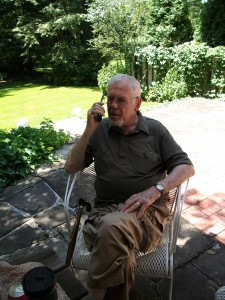
Harold Ticktin, Shaker Heights, 2012
Also, Harold occasionally reflects on early-20th century leftist politics for magazines such as Jewish Currents.
I asked Harold for a couple Yiddish translations. I was in his backyard in Shaker Heights. I wanted to know Yiddish permutations on “How’s it going?” — everything from “How are you?” to “What’s happnin’, man?” Ticktin gave me some options, none perfect, and concluded, “Translation is treason.”
He continued, “Listen, there was this pharmacist who did a big business in trusses – you know what a truss is?”
“Yes.”
“The pharmacist’s slogan was Ayer kile iz undzer gedile — your hernia is our pleasure. I told the pharmacist that was a horrible translation. He told me to come up with a better one. I said, ‘Your rupture is our rapture.’ Wouldn’t that make a great bumper sticker for an abdominal surgeon?”
“Did you make that up — your rupture is our rapture?” I said.
“That’s a true story. It’s an absolutely true story.”
Ticktin is a retired workers’ comp lawyer. He can speak decent Italian, French and Spanish, as well as Yiddish. One of his favorites translations is All Screwed Up, he said, for the Lina Wertmuller film Tutto a posto e niente in ordine, which literally means “everything ready, nothing works.” “You don’t translate, you render,” Ticktin said.
Ticktin continued, “James Thurber ran into a woman in Germany who said, ‘I love your work in German.’ Thurber said, ‘Yes, it’s true, my work loses something in the original.’”
Ticktin lives three miles from his old stomping grounds — the Kinsman neighborhood. Harold grew up on E. 154th Street, Cleveland, hard by the Shaker Heights-Cleveland line. He said Shaker had been “hakodesh hakadashim [the Holy of Holies] — the other.” Shaker had been nearly unapproachable, like the inner sanctum at the Temple in Jerusalem. “I didn’t know anybody in Shaker. Maybe one person.”
Kinsman Road was Ticktin’s main artery. He said, “I walked [down Kinsman] from 154th to E. 140th to observe the class struggle. My father was a Yankee. He came over here when he was two. He liked baseball. What did he know about politics? He knew this: Roosevelt was great and Hitler was bad.”
At E. 146 Street, Harold met Peter “The Brain” Ostrovsky. “I was converted to communism by Ostrovsky on the train to the Philly Navy Yard in 1946. I was converted just west of Pittsburgh.”
The upshot: “I saw the God who was to fail, though I still have a warm spot for Marx, for his Lincoln correspondence,” Harold said. “I’m a member of the extreme center now.”
I wanted Ticktin to give me a tour of Kinsman — the proste, working-class Kinsman of his youth. “How about it?” I said. “Now?” Ticktin agreed. We got in my Lolly the Trolley — my Mercury Sable.
***
Stop 1. Woodhill Park at E.116th. Ticktin: “I remember when I was 10 years old [1937] at Woodhill. It was a tremendous swimming pool. Everybody got out of the water. Why? Because Frieda Katz, a geferlikher (dyed-in-the-wool) communist took a swim with a black kid. The place cleared out. This was Frieda Katz from Katz’s Deli at E. 147th and Kinsman.”
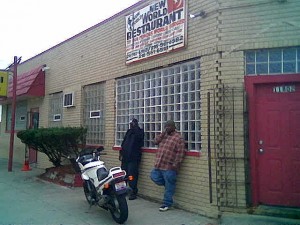
Formerly Seiger’s
2. Seiger’s deli at 118th. “I knew Hymie Seiger best. He went off to yeshiva in junior high. He just left. I didn’t even know what a yeshiva was.”
3. E. 121. “This was where I attended my one Seder as a child. On that street. Very important.” Ticktin eventually became president of his shul.
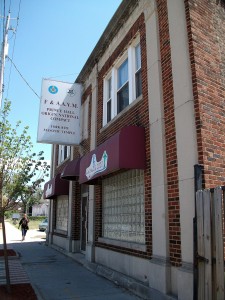
Council Educational Alliance building, now a Masonic hall
4. 13512 Kinsman, the Council Education Alliance. “The apex and GHQ [general headquarters] of my youth. The Communist Club met there.” It was a settlement house.
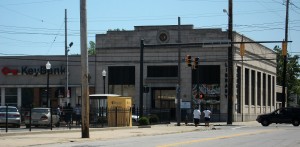
Cleveland Public Library – Mt. Pleasant branch
“In the 1936 election, the Communist Club painted ‘Vote Communist’ in blue on the library at E. 140th. The library had been a bank before. Some members of the club got mad because the graffiti was blue. They said, ‘We need to paint it red.’ Ostrovsky went back to re-paint it and got caught. He was defended by Yetta Land, who handled all the communists. I don’t think Ostrovsky was punished too severely; he was a juvenile.”
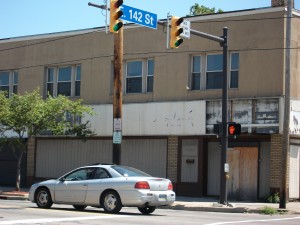
Formerly Spumoni’s (middle store)
5. E 142 and Kinsman. “We called this place Spumoni’s. The real name was Giaimo’s — an ice cream place. The communists met across the street above the Woolworth’s, which is long gone.
“On Saturday nights all the single Jewish guys would hang out here at Spumoni’s and greet each other Marty-style, like, ‘Whadaya want to do, Marty?’ This went on up through the 1940s and 1950s.”
“What’s Marty-style.”
“Like Marty, the movie with Ernest Borgnine. You don’t remember it?”
“No.”
“Single Jews guys — and married Italians — hung out, to go out on the town. I always envisioned a cowering Italian wife in the kitchen back home saying, ‘Tony, when you gonna be home?’”
6. E. 154th / the Shaker Heights line. “Hakodesh — the other,” Ticktin said. “I was in New York once and stopped in at YIVO [Jewish Research Institute] for a list of places European Jews had vacationed before the war. I needed this for a speech in Yiddish. They asked me, ‘You mean intellectuals? Peasants? We’ll get back to you.’ They didn’t get back to me. A couple weeks later, I’m at a gathering of Jews and Poles in Cleveland, an American Jewish Committee meeting, and I meet the speaker, a prominent Polish Jew, Lucjan Dobroszycki, the editor of the Chronicle of the Lodz Ghetto. I ask him about vacation spots before the war. He looks at me and says, ‘This is the second time in two weeks somebody has asked me this question.’ End of the line, Lucjan Dobroszycki — don’t ask me how to spell that.”
7. I drive Harold Ticktin into Shaker Heights. Another end of the line.
—
The photos, above, are from 2012, except the former Seiger’s deli pic, which is from 2010. Seiger’s — later New World Restaurant — is boarded up.
—
The Yiddishe Cup Trio (Alan Douglass, Steven Greenman and Bert Stratton) plays a free one-hour concert 4 pm this Sunday (Nov. 24) at Beth El – The Heights Synagogue, 3246 DeSota Ave., Cleveland Heights.
November 19, 2024 1 Comment
GERSHY AND TOBY

Toby Stratton (1917-1986). Photo 1984.
My father, Toby, took me to a lightning-round tutorial with Cousin Gershy. (Gershy is short for Gershon.) Gershy looked horrible — three strokes and two heart attacks. My dad didn’t look any better. My dad died of leukemia two months later.
Gershy had shotguns, a steer horn and a shalom plaque over the mantle. Gershy said, “You wouldn’t believe it, but I used to be a shtarker (strong guy/bully). Now I’ve got this little curl in the tail — that little something different — that something the new treatment doesn’t cure. You’re in trouble, they say. They say, ‘We can’t straighten out your tail. You’re dead.’ That’s what the doctors tell me.”
My dad didn’t chime in. (The docs guessed my dad had another two years.)
A gun dealer had sold Gershy the steer horn for $50, and now the gun dealer wanted the steer horn back. “Gun dealers is a funny ballpark,” Gershy said. “He could shoot me, but a deal is a deal. That’s the way it is.”
Gershy owned a shopping strip center on Mayfield Road in Cleveland Heights. (The building had Gable Pharmacy and Bass Lock & Key.)
Gershy’s price was too high, Toby said.
“If the kid is interested,” Gershy said, looking at me. “I’d come down.”
“It’s up to the kid,” Toby said.
“I’ll work with him,” Gershy said.
On the drive home from Gershy’s, Toby said to me, “Gershy has mellowed.”
Mellowed? Gershy did not seem mellow to me — not part of the Donovan, mellow-yellow ethos.
“And he’s a gonif,” Toby said. “Don’t buy anything from him.”
I didn’t. Instead I bought an apartment building in Lakewood a year later. I bought the Lakewood building because I wanted to prove to myself I could pull the trigger — buy a piece of investment property — without my dad telling me what to do. My dad was dead. I was 36. I bought the apartment building from a man named Chisling. Odd name, right? I could have used some advice from my dad.
—
Yiddishe Cup is part of the Shavuot celebration 7:15-8 pm Tues. (June 11), Park Synagogue, Pepper Pipes, Ohio. We’re doing a 45-minute concert. For more info, click here.
June 5, 2024 1 Comment
BIKING BACK
I live two miles from where I was born. Every 60 years or so, I bike back to Kinsman – the area my parents lived pre-1951. St. Luke’s Hospital — where I was born — abuts Kinsman. Kinsman used to be a mix of Italians, Jews and Slovaks.
The first time I left home on my own steam was when I biked to Cermak Drug at East 93rd Street and Union Avenue. This was about 1962. I went with Cermak himself — the son of Cermak, actually. The Cermak family lived across the street from us in South Euclid. John Cermak (around age 12 at the time) and I used red city map books to navigate to the city. What were those books called? Street Atlases. Cermak and I made it to the drugstore and back.
 Last fall I biked to a different Kinsman drugstore to get a Covid booster. I couldn’t get it in my neighborhood, so I found a CVS at East 108th Street and Kinsman Road. I mapped out my route. It was like I was going to a foreign land. I biked by Benedictine High and boarded-up Audubon School and Woodland Hills Park, which is now Luke Easter Park. (Easter was a Cleveland Indians player.) The pharmacist at CVS said, “You’re the third person today who said he came from Shaker or the Heights.”
Last fall I biked to a different Kinsman drugstore to get a Covid booster. I couldn’t get it in my neighborhood, so I found a CVS at East 108th Street and Kinsman Road. I mapped out my route. It was like I was going to a foreign land. I biked by Benedictine High and boarded-up Audubon School and Woodland Hills Park, which is now Luke Easter Park. (Easter was a Cleveland Indians player.) The pharmacist at CVS said, “You’re the third person today who said he came from Shaker or the Heights.”
I’ve been through Kinsman many times in a car, but my recent bike thing was the most memorable excursion. I doubt I’ll bike through Kinsman again. I’ll go to Europe.
May 29, 2024 3 Comments
ERIC CARMEN
Pop-rocker Eric Carmen graduated a year ahead of me at Brush High in Lyndhurst, Ohio. He was the leader of The Raspberries (post-high school). Here’s why I didn’t know Eric:
- I was a tennis guy in high school, not a music guy.
- Carmen lived in Lyndhurst — super-goy land. I lived in South Euclid. I knew a handful of kids from Lyndhurst. My friend Ron, who grew up in Lyndhurst, said it was no picnic being a Jew in Lyndhurst in the 1960s.
Carmen was Jewish. Carmen, the name –vaguely Italian. Lyndhurst was vaguely Italian, too. This, just in: carmen is Latin for song. [Thanks to Ted Stratton for the Latin lore.] Eric Carmen attended a Jesuit college, John Carroll University. Strange.
There’s a Facebook page called “I Grew Up in South Euclid/Lyndhurst Club,” which saw a lot of action when Carmen died last month. Nobody on the FB page talked about where Eric Carmen went to temple. I bet he went nowhere. Maybe Eric was “unaffiliated,” as the Jewish-continuity surveyors say. Some press obits said Carmen was the son of Russian Jewish immigrants. The New York Times wrote: “[Carmen was] from a family of Jewish immigrants from Russia.” Yeah, so am I. So is nearly every Jew in Cleveland. Enough with the Jewish stuff. Or not . . .
Carmen’s grandfather was Hector Camingkovich, according to Findagrave.com. The Cleveland Jewish News, 20 years ago, mentioned that Carmen’s father worked at Gould Ocean Systems, and his name was Elmer Carmen. Eric’s mother was Ruth (nee Berns). Do the names Elmer and Ruth sound immigrant to you? They shouldn’t. A 2007 CJN obit said Elmer “enjoyed golf and travel, and was a graduate of Glenville High School and Western Reserve University.” Elmer wound up in a gentile cemetery.
Eric Carmen played sock hops at Brush High. I didn’t cotton to sock hops. (I liked bowling and miniature golf.) Alan Douglass, from Yiddishe Cup, saw Carmen a couple times. I’ll ask Alan about that.
Several commenters on the South Euclid/Lyndhurst FB site segued into naming other well-known Brush grads. For example, there was Steve Stone, a Major League pitcher who won the Cy Young Award while playing for the White Sox, or was it the Cubs? (I gotta look that up . . . Orioles.) Stone’s sister was in my homeroom. Does that count for anything? It better, because I’m sorry I (Brush’68) have no Eric Carmen reminiscences for you. (**please see addendum, under photo)
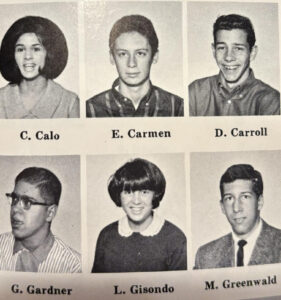
Brush High yearbook, 1966. Carmen’s junior year. (Photo courtesy of Ken Goldberg)
** Alan Douglass, of Yiddishe Cup, ran into Carmen many times at a convenience store in Mayfield Heights in the early 1980s. Alan worked there; Carmen shopped there. Alan said, “He was a ‘has been’ at that point — pre-Top Gun.” Alan had a 45 rpm record of “All By Myself,” which he brought to work for Carmen to sign, but for some reason, the “All By Myself” record and Carmen were never in the store at the same time. Alan said, “I liked everything by The Raspberries and all his solo stuff. He was power pop before there was power pop.”
April 3, 2024 2 Comments
CLEVELAND, CLARINET, COMEDY
In Mickey Katz’s autobiography, Papa, Play For Me, Katz tells some off-color jokes, like “Tailor, I have a problem. I have five penises. Will the pants fit?” The tailor says, “Like a glove.” Then Katz name drops: “I was part of a regular bridge game consisting of George Burns, Dave Siegel, George Raft, and myself. Occasionally Chico Marx.”
Katz kvells about his “creative wife” Grace, and sons Joel and Ron.
Fine, but the best stuff in the book is about Cleveland. Katz mentions many Cleveland landmarks. The first half of the book — before Katz moved to L.A. in 1946 — reads like an unofficial Jewish Encyclopedia of Cleveland. For instance, Katz mentions a musician who went to an East 105 Street bagel shop at 1 a.m. in 1935 and demanded a half-dozen fresh bagels, which he ate next door at Solomon’s deli (along with a corned beef sandwich) because Solomon’s was out of bagels. That’s detail.

Mickey Katz 1959
In 1977, when the book came out, Katz was somewhat famous because his son Joel Grey was huge in Cabaret then. The first line in the book has the words “my son Joel Grey.” (The ghost writer of Katz’s autobio is Hannibal Coons, who was the main writer for the Addams Family.)
A couple decades ago, I took some Katz Yinglish (Yiddish-English) lyrics to a Workmen’s Circle meeting for translation. The translators – generally elderly Yiddishist purists — considered Katz shund (literary trash). Songs like “K’nock Around the Clock” and “Nudnik the Flying Shisl” (Pest the Flying Saucer) were beyond the pale.
I once lectured on Katz at the International Association of Yiddish Clubs convention in Cleveland (2007), and I met two musicians who had worked with him: cantor Hale Porter and singer Tanja Solnik. They had appeared with Katz in Hello Solly, a 1960s off-Broadway show. I asked them what Mickey had been like because I couldn’t tell from the autobio. I didn’t get a good answer from Tanja because she had been only 8 when she performed with Katz. She had been “Little Tanja.” Hale Porter didn’t say much memorable either. But it was interesting — at least for me — to simply meet people who had giggled with Mickele.
Myron “Mickey” Katz (1909 – 1985): Clevelander, clarinetist, comedian.
Katz writes about playing clarinet on the Goodtime, the Lake Erie cruise boat. (I’ve been on the Goodtime, and so has every other Clevelander.) The Goodtime was owned by the Seeandbee line. The “See” is for “Cleveland” and the “bee” is for “Buffalo.” Does that interest you?
February 28, 2024 No Comments
HE PLAYED “OUTSIDE”
A Cleveland friend, Alan Sherwin, started an avant garde jazz band, which I followed around. Me and about two other people. This was in 1975. The band had zero commercial success; however, one musician ultimately wound up in Tin Huey — a big deal in northeastern Ohio — and another guy, a some-time drummer, wound up in Devo.
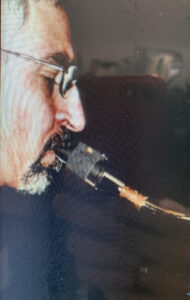
Alan Sherwin, circa 2020
Alan’s band was called Jazz Death. “Jazz Death?”– with a question mark — was the name of a jazz tune written by trumpeter Lester Bowie of the Art Ensemble of Chicago. One couldn’t get more “outside” than Bowie and the Art Ensemble. (“Outside” means playing outside the traditional chord structure.)
Alan outlined Jazz Death’s M.O. to me: “Everybody plays at once but we don’t get in each other’s way.” Besides the Art Ensemble of Chicago and other avant garde groups, Alan also liked bebop: Parker, Monk, Bud Powell. We’re not talking smooth jazz here.
Alan was an electronics teacher at my alma mater, Brush High School. He was pretty much self-taught on sax. He majored in something non-music-y at Miami University of Ohio. He didn’t care what others thought of his musical tastes. He said to me, “I don’t need Downbeat to tell me who to listen to.” He didn’t care who was playing at Slug’s.
Alan was intrigued by my career path. He said I was on “an old Jew trip” because I was going into real estate. No selling out for Alan! He wouldn’t even listen to music while he drove. He needed to sit alone in his apartment and focus hard on the tunes. (He did install a cassette player in my car. He knew electronics.)
Alan eventually moved to Washington, D.C., for a girlfriend, and I didn’t see him for years after that. I looked him up in 2012. Alan told me to learn some jazz licks — “you only need to do it in four keys” — and I’d be decent. Four keys beat 12 keys, but still, I stuck to klezmer for the most part.
A few years ago I sent Alan a comic strip by Harvey Pekar that acknowledged the late, not-lauded Jazz Death. Alan wrote me back, “What is Pekar smoking?” (Pekar was dead but that’s beside the point. The point: Alan was being self-deprecating.) Alan had become more mainstream — less Art Ensemble of Chicago, more Duke Ellington. No more going “outside.”
This link here and this one are all I can find on Alan’s music on the internet.
Wait, I’ll check Spotify . . .
Nothing. Just “Allan Sherman.”
February 14, 2024 2 Comments
MORE BOCA
In the winter, Cleveland Jews retreated to gated landsmanshaft (hometown association) condo developments in Florida to kvetch about the New Yorkers who had cut them off in the deli line earlier that day

Toby Stratton, far left, 1983, Boca. (age 66)
Boca Lago (where my parents lived) was reunion central for alums from John Adams High and Glenville High in Cleveland. My parents wouldn’t play golf with anybody they hadn’t gone to grade school with. Exception: Detroit people were OK. (Detroiters had their own deli, the Detroiter, featuring Motown hot dogs and Vernor’s.) Other acceptable landslayt (countrymen) were Jews from Columbus, Cincinnati, Dayton and Pittsburgh. Those people were OK. They wouldn’t say, “I’m on line. Get behind me!” (Although they might say, “I’m in line. Get behind me!”)
My dad owned a Florida deli. (Actually, he was the deli’s landlord.) Toby owned a shopping strip center in Sunrise, Florida, that had a tenant Tam Tov Deli. The parking lot was always jammed. Cars of old Jews smashed regularly. Above the deli, there was office space, mostly vacant. My dad lost a lot on that building.
My dad liked deli food. I’ve written enough on that subject, but for the record, halvah was a big thing with Toby and doesn’t get enough play in this blog.
Glades Road, Boca Raton, had a Bagel Nosh, which was not up to standards. I told my dad,”We have that in Cleveland and it’s crap.” He agreed.
January 24, 2024 3 Comments
WEATHER KVETCHERS
I employed a building manager who loved the Weather Channel and thought the end of the world was coming daily via tornados or snowstorms. I don’t think she ever went outside in the winter. She said winter was too gray for her.
Bad weather is no excuse for a bad attitude. If you don’t like gray, move or get a sun lamp. More gets accomplished in gray weather. The Scots and New Englanders didn’t invent stuff sitting at the beach.
Another employee was fixated on the weather, too. He did a lot of interior apartment painting and wanted it to be 74 degrees, like Costa Rica, so he wouldn’t sweat.
My parents had a condo in Florida. So did my in-laws. In fact, my folks and Alice’s parents lived in the same development (Boca Lago, Boca Raton) and got along better than Alice and I.
I’m not a Florida fan. Too hot. I know a klezmer musician — a bushy-haired baby-boomer — who moved to Florida and took up golf. Maybe he played a freylekhs (hora) by the water fountain on the 16th hole at Boca Lago. (Mickey Katz did that, although not at Boca Lago. His band got paid to surprise a golfer on his birthday at a golf course somewhere.)
Arizona versus Florida – that’s the question here in Cleveland in the winter. Alice and I went to a wedding in Florida, where a guest asked us, “Are you still in Cleveland?” That meant: “Are you nuts? Do you like snow, gray skies, slush and potholes?” Don’t mind those things. I went walking yesterday in very cold weather. As they say, there’s no bad weather, just bad clothes. I think a Scandinavian said that.
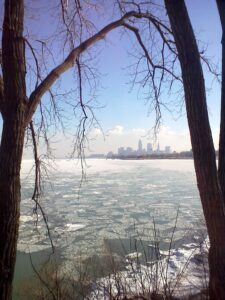
Lake Erie
Another Cleveland woman at that Florida wedding said, “The day I hit 62, I had to leave Cleveland.” She now spends her winters in Scottsdale. A third Clevelander — originally from South Africa — said she preferred Florida over Arizona because of the water. “I like the ocean,” she said.
Lake Erie is the “ocean.” Look it up. Cleveland is doable.
One last word: layers.
—
Here’s my op-ed from the 1/11/24 Wall Street Journal. (No paywall) “Wait a Minute, Mr. Postman.”
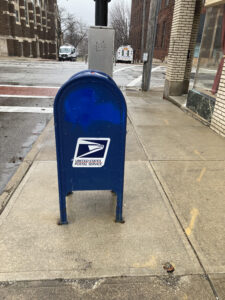
a blue-ish mailbox
P.S. re: mailbox story . . . Yesterday I got a FedEx gift of a carton (12 cans) of USPS spray paint from a mole deep in a paint factory. The mole’s note read, “Always paint with the correct color.” (If you need a can of Postal Blue, let me know. But I don’t ship.)
Please read my WSJ article if this is all Greek to you.

The real stuff
January 17, 2024 3 Comments
DELI DEATH
My kids liked Corky’s. The blintzes, the pickles, the halvah, the phosphates. But I’m not here to write food nostalgia. Too cheesy.

C&L’s closed, for good, Tuesday. The word in the local press — Cleveland Jewish News and the Plain Dealer — is C&L’s had a problem getting good help. That ain’t news. I’m skeptical.
My dad was a chocolate-phosphate addict. So is my daughter, Lucy, who called the phosphates “chocolate frost feets.” Cleveland musician Mickey Katz, in his autobiography, called chocolate phosphates “Jew beers.” (Katz’s son is Joel Grey.) Katz drank “Jew beers” at Solomon’s Deli on East 105th Street in Glenville.
My father, Toby, was a “deli Jew.” That’s typically a putdown in the Jewish community, meaning my father knew more about corned beef than Torah. Toby’s favorite food was a “good piece of rye bread.”
My father probably drank no more than 100 real beers his whole life. He should have! In his retirement — when he drank more — he smiled a lot more. A bit shiker at one party, Toby teed off on a watermelon fruit bowl with a golf club. The golf club was a driver, a wood. Solid.
I grew up on chocolate phosphates, just like my dad and my kids. I drank many of mine at Solomon’s in the Cedar Center shopping strip in South Euclid, where Solomon’s had moved — from East 105th Street — in the 1950s.
For some Semitic, semantic reason, goys occasionally called Cedar Center the Gaza Strip. This has nothing to do with the present war. It’s just the word strip, as in Gaza Strip and shopping strip, made for an interesting juxtaposition. The north side of Cedar Center looked pretty bad, actually. In the early 2010s it was concrete chunks and gravel heaps, until a real estate developer knocked down the 1950s-era plaza and put up a Bob Evans and other national chains.
Bob Evans is good. Not knocking it.
The C&L’s at Cedar Center lasted until 1994. A second Corky’s opened further east in 1973. That one — the “new” one — just closed. Confused? Simply put, there are no more C&L’s in Cleveland.
At Cedar Center Corky’s, a couple small tough Jews hung out in the rear booth. One was Bobby (pseudonym.) Bobby did collections for a major landlord. Major, to me, meant more than 500 units. I knew Bobby from junior high. Bobby sued my mother. Mom, for health reasons, had moved from her Beachwood apartment, where Bobby collected rents, to an assisted living facility. She had a couple months left on her lease. She had lived in the apartment 27 years. Bobby went after her. Bobby’s boss, by the way, loved my band. So what, my mother was collectable.
Delis have been going downhill for decades. In 2010 journalist David Sax wrote a book, Save the Deli, about the decline of the deli. Here’s something for your next edition, Mr. Sax; Delis went downhill when they added TVs. Why are we forced to watch sports while we eat?
I’m deli-famous. Listen to me. I once wrote a thank-you note which was posted in the entrance of Jack’s Deli on Green Road in Beachwood. My letter was about the terrific tray Jack’s had prepared for the bris of my first child, Teddy. (Jack’s Deli is still standing.) Oh yeah, my first bris as a dad . . . fatherhood was about buying huge quantities of smoked fish. In my letter I complimented Jack’s on their white fish, which my Aunt Bernice the Maven approved of. I used the expression “Aunt Bernice the Maven gives her seal of approval” in my letter. Bernice worked for a food broker and knew food.
Do you prefer Jack’s Deli or Corky & Lenny’s? I asked that question just last week at a gig. I queried a nursing-home crowd about their favorite deli. Jack’s and Corky’s ran a dead heat. After my quiz, my keyboardist and I played the song “16 Tons (of hard salami),” which is the Mickey Katz parody of Tennessee Ernie Ford’s “16 Tons” (of coal).”
Yikhes (lineage): My dad grew up in a deli on Kinsman Road. His mother had a candy store /deli at East 118th Street and Kinsman. The deli was called Seiger’s — my grandmother’s maiden name. She sold it to her half-brother, Itchy, when he came over from the Old Country. Something fishy about that deal. My grandmother went from being a candy store/deli owner to simply a candy-store owner.
I once played the “deli card” to establish my bonafides. In an odd place. I was working as a police reporter in Collinwood, and the cops at the police station on East 152nd Street considered me a Jewish hippie spy from the Heights. But when I told the cops I was a Seiger, as in “I’m from Seiger’s Restaurant, you know, on East 118th and Kinsman” — the older cops suddenly took a liking to me. The older cops—mostly high-ranking guys — knew Seiger’s Restaurant well. Seiger’s had been like a Damon Runyon casting hall; all manner of hustlers, cops, businessmen, and schnorrers had hung out there. (Seiger’s closed in 1968.) The schnorrers were Orthodox Jewish tzedakah (charity) solicitors; they had their own booth in the back. My great-aunt, Lil Seiger, served the schnorrers kosher food from her apartment, which was in back of the store, because the schnorrers wouldn’t eat the non-kosher food. The deli was kosher-style, not kosher. Cops ate well at Seiger’s, and nobody ever got a ticket for an expired meter, and sometimes cars were parked two lanes deep on the street, an old cop once told me. Itchie Seiger, my great uncle, was the restaurant’s maitre d’, a k a kibitzer (glad-handler). He was a former cloak maker from Galicia, a province in Austria-Hungary. My grandmother Anna Seiger Soltzberg was a Galitizianer, as well.
I personally didn’t see Itchie very often. My parents didn’t consider a drive from our house in South Euclid to Kinsman the right direction for a Sunday cruise. We usually wound up going east, toward the Chagrin River metro park.
My great-aunt, Lil, supposedly gave her recipe for mish mosh soup to Corky’s. All the deli owners knew each other. So I’m connected to Corky & Lenny’s. Pass the Jew beer. Slurp.
—
A lot of this post originally appeared in Belt Mag in 2014. The graphic is by Ralph Solonitz.
I had an op-ed in the Wall Street Journal last week. “Maimonides Goes Wrong.” It has the word schnorrer in it, too. Link here. No paywall.
December 12, 2023 1 Comment
HERBERT GOLD
OF HATHAWAY AVENUE
I wanted to be Herbert Gold, who wrote for Playboy and other mags. He also wrote novels about growing up in Cleveland. They weren’t good novels. They were too wordy, going in circles. He couldn’t do plot. (Not too many people can.)
Gold was one of a handful of Jews who grew up in Lakewood in the 1920s and 1930s. He lived on Hathaway Avenue. He died on Nov. 19 at 99 in San Francisco. His father ran a small grocery store in Lakewood, and the father — unlike most Cleveland Jews — didn’t settle on the East Side. (Lakewood, on Cleveland’s West Side, was beyond the pale for Jews back then, and still is to some extent.)
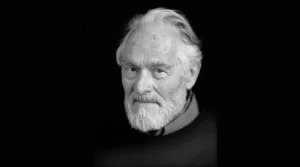
Herbert Gold. circa 2010.
I passed Gold’s house on Hathaway Avenue in the 1970s on my way to managing apartments in Lakewood. I had unpublished novels; I had a lit agent in New York. I wanted to be the “next Herbert Gold,” though slightly better. Instead, I became the “first Bert Stratton.”
The Prospect Before Us was Gold’s novel about managing a rundown hotel on Prospect Avenue in Cleveland. You’d think a book with such a good title would be good, but it never went anywhere. It wasn’t funny or tragic. Don Robertson, another local novelist, was better. Robertson could be funny, for one thing.
Gold’s memoir My Last Two Thousand Years — about his father and Herb’s relationship to Jewishness — was moving. He wrote, “My father came to America from Russia and lived in a basement on the Lower East Side. I came to America from Lakewood to live in a basement on the Lower East Side. I washed dishes, cleaned rooms, waited on tables and tried to learn a little Yiddish [1942, NYC].”
Gold moved to San Francisco in 1960 and stayed there. He visited Haiti often. I occasionally saw his brother Sid on Coventry Road in Cleveland Heights. Sid was a Coventry cowboy — a regular in Harvey Pekar’s comic books. Sid didn’t have a job and played a lot of chess.
In a 2021 interview, Gold said, “I’m very preoccupied with the fact that I’m not going to live forever. Death is inevitable and I have to accept it. I’m comforted by the fact that a few people, my children, will remember me or will inherit something from me, and I will be immortal in that sense.”
Herb Gold: a Jewish writer from Lakewood, Ohio. I gotta drive by his childhood house at 1229 Hathaway Avenue again.
—
I had an op-ed in the Wall Street Journal on Nov. 16. “My Gaza Friend is Dead.” [No paywall]

Baraa Abu Elaish (L) and Alice Stratton. Fairfax Elementary School, Cleveland Heights, Ohio. 2014.
—
On a lighter subject, here’s my essay in today’s Cleveland Plain Dealer. “Pondering signs, borders and license plates.”
—
Yiddishe Cup plays a free concert 2-3 pm this Sun. (Dec. 3) at the Beachwood Community Center, 25225 Fairmount Blvd, Beachwood, Ohio. Be there!

Plain Dealer ad, 6/24/36
November 29, 2023 3 Comments
HOW TO OUTLIVE YOUR PARENTS
Do everything right — and if you’re lucky — you could make it to 94. (I’m not talking 100. That’s freak show.) Take Bob Gries, a prominent Clevelander who died last month at 94. He exercised two hours a day, according to his obit. I suppose one could subtract two-hours-per-day from his lifespan and conclude Gries “lived” a lot fewer than 94 years. Depends what you think of exercise. Bob Gries enjoyed exercise — a lot.
Here’s a funny bit from his obit:“[Bob] wrote a book called Aging with Attitude, which highlighted some of his 100+ adventures and the importance of a daily workout regimen. After reading this book, people told him they were inspired while others said they had to take a nap!” Gries was an endurance runner (100-mile races). He climbed mountains in Antarctica and the Arctic.
Gries was “Our Crowd,” old Jewish money (Cleveland chapter). He was a descendant of the first Jewish settler in Cleveland, a merchant who arrived from Germany in 1837. Gries’ grandfather was the rabbi at The Temple in the early 20th century. The Gries family — through Bob’s mother — owned the May Co. chain in Ohio. The Grieses also owned a minority share of the Cleveland Browns. I could go on.

Bob Gries
I will. Bob Gries’ father went to Yale in the 1920s. Bob went in the 1940s. In the Cleveland Jewish News obit, one of Gries’ sons said Bob served on so many some boards in Cleveland because Bob’s pop had not been welcomed on many boards because he was Jewish. Sounds about right for back then.
In the early 1990s, I saw Gries — all farpitzed in a white linen suit — welcome approximately 2,000 proste yidn at a Yiddish concert at Cain Park, Cleveland Heights. Bob was repping the Jewish Federation of Cleveland. He was suave bolo and fit.
The last time I saw Gries was about three years ago on Public Square. He, along with a health aide, were checking out a fringe festival. The man got around.
Dead at 94. That’s good mileage, right? Lessons? He exercised a lot, had health aides, a lot of money and a big family, and he was very involved in the community. Genetics was probably a factor too. I haven’t considered that.
. . . Just did. I considered it — genetics. I just googled Gries’ parents. They died at 65. Dad in 1966 and Mom in 1968. Climb a mountain in Antarctica. You’ll outlive your parents.
—
Yiddishe Cup plays a free concert 2-3 pm Sunday, Dec. 3, at the Beachwood Community Center, 25225 Fairmount Blvd., Beachwood, Ohio.
November 21, 2023 3 Comments
VIOLET SPEVACK
Violet Spevack, the retired gossip columnist for the Cleveland Jewish News, died last week. She was 107! Born in 1916.
Violet mentioned my band, Yiddishe Cup, a lot. I had an “in” with her. Vi knew my parents from Temple Emanu El (Cleveland), which was originally an offshoot shul that Violet was a founding member of, and my parents had joined. Temple Emanu El was known for being heymish — not snooty. No old German Jewish money. The big money at Emanu El was Maurice Saltzman, the Bobbie Brooks founder. Saltzman grew up in an orphanage.
Violet would call my band “freyleky,” “toe-tapping,” “joyous,” “finger-snapping,” “multitalented,” and “may their cups runneth over.” I had my picture in that column almost as often as the presidents of the Jewish Community Federation of Cleveland.
Vi never said a bad word about anybody — in print. Off the record, she warned me not to tangle with certain heavy-hitters in the Jewish community. For instance, one heavy-hitter, who was bossy, dissed my band by saying “Your band is sounding better.” That meant we weren’t up to her level. I was a bit sensitive back then! This disser ran a Jewish organization that wouldn’t hire us. Vi said, “That woman is very powerful. Steer clear.” I did — for decades. Funny, I eventually became friends with the disser, and she started to like my band. Violet loved all kinds of music. Her husband, David, played harmonica. He was a big fan, too, of Yiddishe Cup.
The only problem with Vi was she was from Glenville (a Cleveland neighborhood). The sheyne yidn (higher class Jews) lived in Glenville. Everything in her columns was Glenville this, Glenville that. You’d think Glenville was the center of the world. (She had been an editor of the Glenville High school paper in the 1930s.) Hey, my parents were from the more proste (working-class) part of Jewish Cleveland, Kinsman. John Adams High. Vi tolerated John Adams rivals and their descendants!

Vi Spevack
Reunions in Florida for Glenville snowbirds — those were always newsworthy in Vi’s column. The Glenville diaspora ruled. If you had gone to Glenville High and moved to California, you could get ink in Vi’s column for having, say, a good round of golf in Palm Springs.
Violet was all about the phone. Never email. She would write out quotes (from me and other interviewees) longhand and then type them up. She usually called me before publication. Together, we fine-tuned copy. For instance, she would say, “How do you like ‘The heymishe Yiddishe Cup performed with spirit and ta’am (taste)?’” Violet, how about fewer Yiddish words? I couldn’t say that. Violet had her go-to Yiddish stable of well-known Yiddish words, and she worked it hard. She really liked freylach (happy).
Here’s another Yiddish word for you, Vi. Mentsh. As in, “Violet was a mentsh.”
—
[The photo of Vi is from when I was at her Sherri Park apartment in Lyndhurst in 2012. She was 96. We were talking about Mickey Katz, who she knew from . . . . drumroll, Glenville.]
September 13, 2023 2 Comments
BRUDNO
Eugene “The Eggman” Brudno sold eggs to bakeries and came to a lot of my gigs. Eugene’s brother, Walter, also sold eggs. Eugene was involved in the Workmen’s Circle. I knew Walter’s son, Marshall, who sold eggs too.
Marshall, now 76, dropped out of Michigan, sold eggs, opened a hippie food store called Marshall’s Grain and Bean; opened an organic bakery (this was in the 1970s) called Stone Oven (different than today’s Stone Oven); closed the bakery; became a plumber; got religious, then got not-so religious; and moved to a farm in southern Ohio.
I was in southern Ohio on a bike trip in 2010 and bumped into Marshall at the Grange Hall in Amesville, Ohio. He offered Alice and me a lift in his pick-up truck. I turned him down but Alice took him up on it. We were on a group ride, the Great Ohio Bicycle Adventure (GOBA).
Marshall is a smart guy who works with his hands. He’s good at snaking drains. He’s good at eggs/ farming/ bread/ plumbing. All hands-on. I think he still does plumbing. I haven’t seen him in 13 years. Marshall knows a lot of Yiddish. He used to daven at an Orthodox shul in Cleveland Heights.
I think about Brudno, the name, a lot because I regularly see Brudno etched in stone on a West Side building. The Brudno building is on Detroit Avenue in Lakewood.
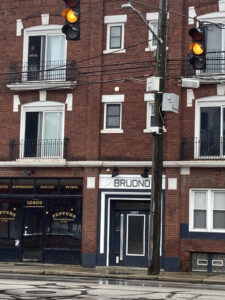
A 19th century Brudno went off to Yale and became a lawyer and novelist. This was in the 1890s! Ezra Brudno. He built the Brudno building in the 1920s. Ezra’s dad ran a cigar-rolling sweat shop. I’ve read about Ezra and his family in the archives at the Western Reserve Historical Society.
The Encyclopedia of Cleveland History states: “He [Brudno] wrote that there was little, if anything, of value in Judaism and Jewish culture worth preserving.” Harsh.
Cigar-rolling shops were common at the turn of the 20th century. The shops were often in houses. In Cleveland, the cigar-rolling houses were called “buckeyes.” I read an account of a worker who worked for Ezra’s father. The worker was a communist. She wrote about what a hole the place was. She also wrote about Ezra: “He had all the luck.”
Marshall — my generation — was the ultimate hippie. He probably still is. According to Facebook, he has a small finca in Costa Rica, where he goes in the winter, and the rest of the year he lives on a farm in the hills outside Athens, Ohio.
Brudno: the building. The Brudno men, the legends, right here.
—
Yiddishe Cup plays a free outdoor concert 7 pm. Thurs., Aug. 17, at Walter Stinson Park, 2301 Fenwick Rd., University Heights. Bring a blanket or chair. We’ll play klezmer and Motown. The concert is dedicated to the memory of Walter Stinson, a University Heights community coordinator.

Yiddishe Cup. 1993. (Half the guys in this photo are still in the band — 30 years later. The left half.)
August 8, 2023 4 Comments
THE TOUR GUIDE
I put up signs on the bulletin board at the downtown Y, offering tours of Cleveland. I was expecting some Danish girls. Maybe Dutch. (I got neither.) I checked out some other Cleveland tour companies. I went on a Grey Line bus tour. “Best water in America — Cleveland’s tap water!” the guide said. Good to know. I rode Lolly the Trolley.
My itinerary of Cleveland was better than these guys. Roll a few bowling balls at that four-laner in Fleet-Broadway, followed by duck at John’s Café on E. 52nd Street. Visit the abandoned power plant in the Flats. (This was approximately 1975, amigos.) Explore the subway route under the Detroit-Superior bridge. Sniff unfiltered steel-mill air atop the scenic Clark Avenue bridge.
No tourists came by. Not even one. Cleveland is not the greatest tourist town. Don’t blame me.
Thirty-six hours in Cleveland . . . The Rock Hall, Severance Hall, the art museum. And if you want to see the Roxy Burlesque and Jean’s Funny House, contact me.
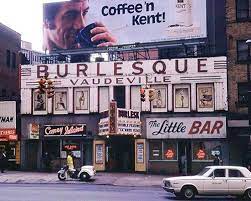
The Roxy on E. 9th Street, Cleveland. (It closed in 1977.)
July 19, 2023 2 Comments
MICKEY
Mickey grew up on the street over from me. He had seven siblings. His dad was a Sealtest milkman. Mickey scored touchdowns. Who can forget his touchdown run against Wiley Junior High? And there was one against Memorial Junior High, too, I seem to recall.
We didn’t hang out that much in high school. So be it. Mostly grade school and junior high.
After Bowling Green U., Mickey moved to Texas and then to Washington state, and I only saw him at funerals and reunions in Cleveland.
A few months ago, he texted me: “I’m back in Ohio.”
What did that mean exactly?
Lake County. He moved there. Mickey moved back to northeast Ohio to retire. Nobody moves to Ohio to retire! He said he moved back here to be closer to his siblings. Ohio has always felt like home, he said. We met for lunch and talked about old times. He asked if I had ever lived outside of Cleveland, and I told him about my three weeks in New York City and three months in Latin America. Pathetic, I know. We talked about Cub Scouts and which neighbors had died.
Mickey’s move to Ohio is a nice change of pace. (Some of my recently retired friends are moving out of Cleveland.)
—
I had an op-ed in the Wall Street Journal last week about accosting random people and talking Spanish with them. “For a Language Lesson, Oprima el Dos.”
March 22, 2023 2 Comments
CANADA IS BETTER THAN
THE UNITED STATES
My friend Jeff didn’t like Cleveland. He didn’t like tumult: the horns honking, boom boxes, loudmouths, leaf blowers, his parents pestering him. He just couldn’t take it.
I subscribed to Hockey Night in Canada on cable TV for Jeff, so he would babysit my kids for free. Every Saturday night. He liked Canada — really liked Canada. He filled out immigration papers, waited months for clearance, got a job, and moved to a small town in Ontario. He came home the next day. He said he didn’t like the job in Canada, but he liked the Canucks. “They don’t give you the finger,” he said.
Then he moved to Canada again. This time to Nova Scotia. That worked. Change your place, change your luck.
I haven’t seen Jeff in 28 years. I miss his acerbic slant on life. For a social worker, he was a total misanthrope and blisteringly funny. “Life is With People” was not Jeff’s M.O. He liked to eat Mrs. Paul’s fish sticks alone. He criticized me for going to restaurants too often. He claimed I was on a fruitless existential search for exotic experiences – for foods my bubbe and mother never made. He claimed I would “eat flanken cooked directly off the seat cover of a crosstown bus.”
We listened to Bob and Ray records, played music, and made fun of other Jews. Jeff knew some Yiddish — more than me. His favorite expression was Gey mit dayn kup in drerd. (Go to hell. lit: go with your head in the ground).
I had to drive Jeff everywhere. Lazy guy, and he had a car. I would schlep him to the Near West Side to hillbilly bars so he could jam with bands. He would play “Two More Bottles of Wine “and “Jambalaya.” That was real; it wasn’t Jewish. His favorite records were Nashville Skyline and anything by Hank Williams. Jeff sang only once on the East Side, at a cancer fundraiser at Heinen’s supermarket. He played “Good Old Mountain Dew” by the soda pops and “Oh Canada” by Canada Dry.
—
Here’s an essay I had in the Cleveland Plain Dealer last week (Nov. 30). There’s a paywall at the Plain Dealer. Here’s the whole article . . .
WHO’S YOUR FAVORITE BAND?
by Bert Stratton
CLEVELAND HEIGHTS, Ohio — I occasionally run into young people who lament they didn’t live through the hippie era. They will even listen to my hitchhiking stories. Nobody else will. I tell these young people that the big question in the late ‘60s and early ‘70s was, “Who’s your favorite band?”
The more obscure the band, the better.
Some astute choices were The Stooges, the Flying Burrito Brothers, and Commander Cody and His Lost Planet Airmen. More mainstream, but still acceptable, was Frank Zappa’s Mothers of Invention. Too mainstream: Bob Dylan, Jefferson Airplane and Joni Mitchell.
My favorite musician was Fred Neil, a Greenwich Village singer/songwriter. He wrote “Everybody’s Talkin’,” the theme song from the movie “Midnight Cowboy.” Harry Nilsson sang the movie track and made it popular.
Fred Neil was never popular. Good — for me. I sold my Fred Neil records a few years ago. Pete Gulyas, the owner of Blues Arrow Records in Collinwood, said my Neil recordings were worth more than all my Beatles and Dylan records combined. When Pete looked through my records, we found a receipt — $1.50 from Mole’s record store. Where was Mole’s? (It was on Coventry Road in Cleveland Heights.)
Comic-book writer Harvey Pekar used to rifle through my albums. Talk about a record snob – Pekar. The only album he ever wanted was my “Charlie Parker Memorial Album,” Vogue Records, England, 1956. I didn’t sell it to Harvey. I figured if Pekar wanted the record that badly, it must be worth something.
Pete the Record Guy looked through my albums three times, and I bid adieu to “Aretha Live at the Fillmore West,” Herbie Mann’s “Memphis Underground,” and “The Paul Butterfield Blues Band” ….
Who’s your favorite band now — in 2022? Are you even allowed to have a favorite band? Yes, you are, and you are encouraged to.
Every year in early December, the music-streaming service Spotify spews out data to its 456 million users, itemizing each listener’s most-played tunes of the past year. This annual reckoning is called Spotify Wrapped. Many fans share their Spotify Wrapped profile online; it’s the equivalent of showing off one’s record collection, circa 1970. Your Spotify Wrapped is your cultural ID badge.
I expect my Spotify Wrapped 2022 will feature Joni Mitchell, Leonard Cohen and some newer acts, like Vulfpeck and the Fearless Flyers. (My son Jack is in Vulfpeck. He schools me on post-1975 music.) Songs older than 18 months represent 70% of the U.S. streaming music market, according to MRC Data, a music-analytics firm.
I rinse my dinner dishes to Joni Mitchell and often add Paul Butterfield for pot-scrubbing. Klezmer music is good for putting away leftovers. I’m not only Spotify Wrapped, I’m Saran wrapped.
I hitchhiked from Los Angeles to Chicago in 36 hours in 1973. That was a land-speed record for hitching, I think. The big hit on the radio then was, “Tie a Yellow Ribbon Round the Ole Oak Tree.” I learned to drive a stick shift, jerkily. The car owner was a Marine from Camp Pendleton, California, on his way to visit his girlfriend in Chicago. At nearly every rest stop, the Marine threatened to trade me in for a more seasoned stick-shift driver. But we made it to Chicago. Tony Orlando and Dawn are not on my Spotify Wrapped.
Who’s on yours?
Bert Stratton lives in Cleveland Heights and is the leader of the band Yiddishe Cup. He writes the blog “Klezmer Guy: Real Music and Real Estate.”
December 7, 2022 11 Comments
LOSING MY CREDIT
Last week I lost my credit card and went around town looking for it. (Been there, done that, you say.) I retraced my steps to On the Rise, the neighborhood bakery, and the clerk there had about 20 cards in a drawer. One card belonged to a friend of mine. My card wasn’t there.
It had to be there! I had just done an in-depth regression analysis of every place I had been in the past three days. You know how hard it is to recall everything you’ve done in the past three days? Particularly when you’re 72.
My friend — the guy whose card I had found in the pile at On the Rise — texted me, “Crikey!!!!! That is so weird. Thank you for the heads up.”
I wish store clerks called when they found cards.
I monitored my online statement. I didn’t freak out. Yippee. Nobody was charging anything. If my card didn’t show up soon, I’d call Visa and ask for another one. My son Ted said, “Don’t say you lost it. They’ll cancel your card.” Right-o, Ted. I don’t want to spent two hours online changing all my auto-pays.
Yesterday I was at CVS to pick up a prescription and asked if by chance they had my card. I had also been there the week before to pick up some generic Lipitor. But I had paid cash then. The pharmacist held up my card and said, “I’ve been on a spending spree!” That was funny.
To repeat, I think stores should call when they find cards. (I suspect many stores do.) I didn’t ask the pharmacist why she didn’t call. I didn’t want to wreck my good mood. I love finding things I’ve lost.
[A Harvey Pekar tribute post.]
—
Yiddishe Cup plays 7 p.m. Thurs., Aug. 18, at Walter Stinson Park, University Heights. Bring a chair or blanket.
August 10, 2022 5 Comments
SAVE HORSESHOE LAKE
Losing Horseshoe Lake in Shaker Heights means losing an important piece of history, along with priceless water views and the dam’s role as a public living room for dog walkers, bird-watchers, and parents pushing strollers.
I didn’t write that. Cleveland.com and Plain Dealer reporter Steven Litt did. [“Removing Horseshoe Lake Dam releases a torrent of potential,” July 29.] In 2019, before the lake was drained, Horseshoe Lake was a “living room.” It was homey — a throwback to an era when people walked around a lot and bumped into each other. Like what we still do at the grocery store. Say, Zagara’s grocery store in Cleveland Heights, except no Cheerios and soy milk at Horseshoe Lake. Only warblers, herons, ducks and sunsets. Free, too.
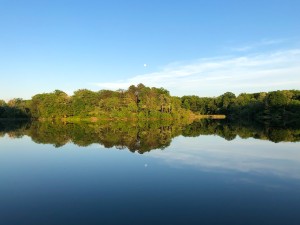
Litt wants to demolish this living room. Litt favors the Northeast Ohio Regional Sewer District’s plan to turn the lake into two streams. We already have miles of streams! We have the Nature Center at Shaker Lake right next door, with its boardwalk, gazebo and illustrative signs.
The other day I was at Cumberland Pool, Cleveland Heights. Johnny Weissmuller once swam there. The pool is a treasure. Why? Because it looks like it did when Johnny Weissmuller swam there. Some things of beauty should stay the same. Want to knock down the Cleveland Museum of Art’s 1916 main building and give it a re-make? Would we sell the museum’s painting “Stag at Sharkey’s” by George Bellows?
Nobody ever lost his life in a flood at Shaker Lakes. Why are we going nanny-state to make sure the dam is 110% safe? Again, nobody ever — in the Heights or University Circle – lost her life in a flood in the 170-year history of the man-made Shaker Lakes and dam. There is this Talmudic precept “whoever saves one life, saves the entire world.” But come on, this coddling is ridiculous. The sewer district fears flooding under the Rapid Transit bridge in University Circle, where there is one apartment building – one – that might get flooded. Somebody should buy that old University Circle brick apartment building and vacate the ground floor; pour concrete in it; and call it a day. (I’m doing that tomorrow! joke) Then the old building will look like the science fortresses around that part of University Circle. We’ll be fine.
The sewer board hired a landscape architect from Cambridge, Mass. One of the firm’s owners is Lauren Stimson, who according to the website, “has a deep love for New England, where she was raised, and an interest in the overlap between the built environment and the rural landscape.” Gotta love New England. And here in Cleveland, we have locals with a deep love of Cleveland — locals with the common sense to realize we have a beautiful lake, and it should stay that way.
The Friends of Horseshoe Lake has hired an engineering firm, public-relations firm, and a law firm to fight for the preservation of Horseshoe Lake. Don’t be misled by the sewer people and the Plain Dealer. Check out SaveHorseshoeLake.com.
—
Here’s my recent op-ed in the Wall Street Journal: “Finding a Good Plumber is a Heavy Lift.” Read the comments — a lot of ranting about how young people should go into plumbing instead of film studies.
August 3, 2022 1 Comment



